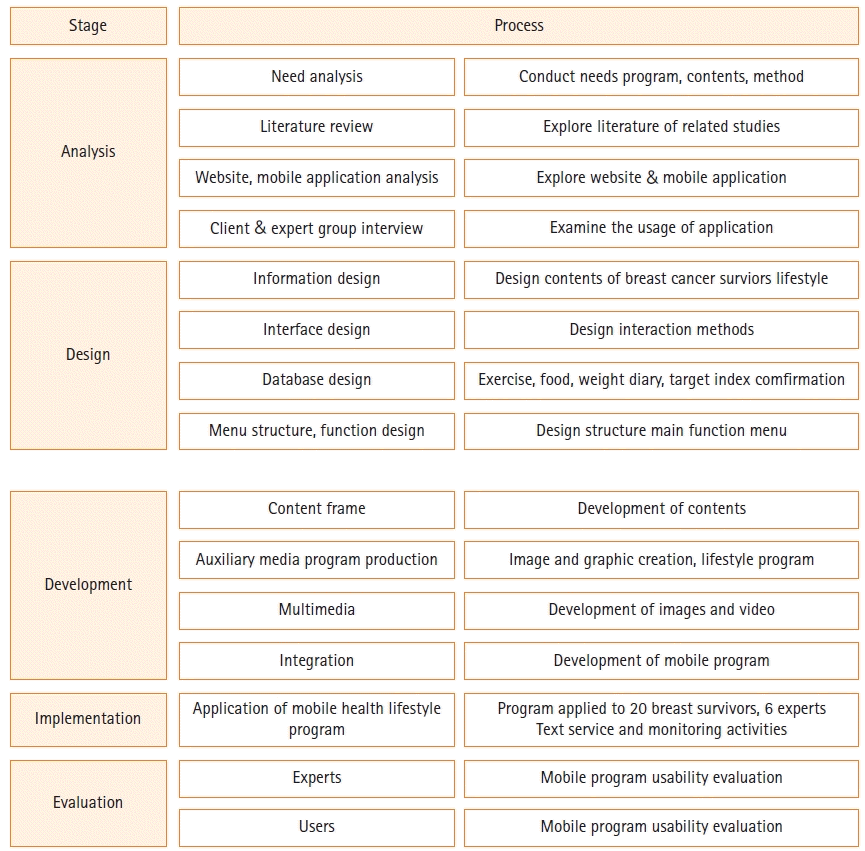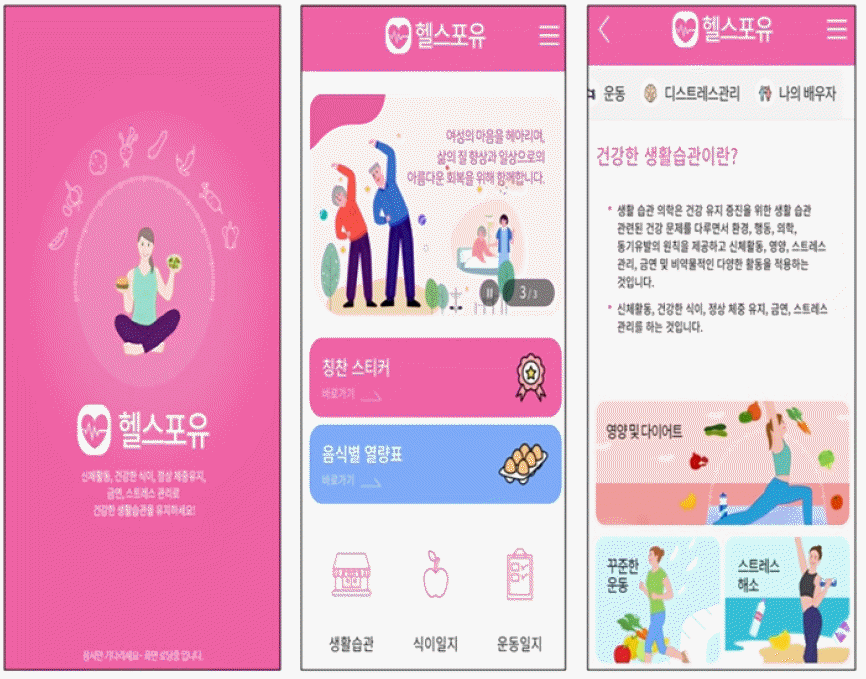Design phase findings
Determination of the structure and requirement function, definition, and flowchart of the application led to designing main menus and submenus. The main menus included application introduction, diet, exercise, distress, spouse and intimacy, target index verification, bulletin board, and archives. Cool diet, diet rules for weight loss, low-calorie food selection, energy intake determination, calorific comparison, diet diary preparation, food calorie table designed by exercise method, weight loss success strategy, aerobic exercise type, muscle training guide, weight log preparation, and distress self-test are included. Submenus were created for announcements, frequently asked questions, and breast cancer-related archives.
The components of the application were established, and the details and methods of the application were designed (
Figure 1). The items developed in this study consist of six categories: dietary management, exercise management, distress management, spouse participation, goal index verification, and data room.
First, dietary management conveys information about diets that would make the subject aware of the importance of lifestyle and have the correct dietary habits. Clicking on “diet” on the menu provides information on topics such as breast cancer and obesity, lifestyle definition, the importance of a healthy lifestyle, breast cancer, weight-loss method, dietary control method, and the calorimetry table by food and by cooking method. A daily dietary diary was prepared to display the results on the calendar to display the number of meals consumed every day which can help identify the importance of proper diet management.
Second, clicking on “exercise” shows videos on exercise methods, weight-loss exercises and strategies, brain yoga, aerobic exercises, stretching guides, muscle exercises, and theoretical information. Daily exercise logs include the type, time, and the number of steps, and the results are linked to the calendar.
Third, the submenu on distress management consists of the definition, self-test, and ways to overcome it. The definition provides an accurate understanding of the distress experienced by cancer survivors, and the self-test items provided an index of distress with specific distressing self-test items such as physical, real-life, family, emotional, spiritual, and religious problems. Maintaining a healthy life, actively managing physical symptoms, building positive experiences, getting help from experts if necessary, and talking to people helps in overcoming stress.
The option, “Spouse and Intimacy” in the fourth menu consists of compliment stickers, making healthy food, doing aerobic exercises together, and creating happy canvas frames. It is intended to increase the intimacy of couples by listing activities that they can do together.
Fifth, the goal index verification was including goal of program. The program recommended to consistently eat three meals a day for more than 20 minutes with many vegetables or fruits, and drink sufficient amounts of water. Specifically, the goal is to “walk more than 10,000 steps a day” and “stretching more than twice a day” to the point of sweating for more than 30 minutes. The goal index is checked and recorded in the diary every day. To relieve stress, there are checkboxes with phrases “satisfied with myself today,” “happy day,” “went to bed comfortably without worrying,” and “sleeping well without waking up in the middle.” The options, “walking with my spouse,” “stretching with my spouse,” and “sending compliment texts once a day” are configured to check the relationship with the spouse and to fill out the daily target index in the diary. This space supports interaction with the spouse, and increases the time spent on exchanging messages and providing active support.
Finally, the data room comprised information on BCSs such as sex life, and lymphedema definition and prevention. It also included “Q&A,” “Notice,” and “Question Room.” In the question room on the main screen, opinions are exchanged, and questions are answered and supported by nurse.
The application has a variety of menus and is designed to be convenient for finding submenus. The two menus are for BCSs and administrators. For the former, it is divided into application introduction, diet, exercise, information space for breast cancer patients, spouse and communication space, and bulletin boards for communication with administrators. The other is for the administrator to check the information entered by the patient. The layout is configured to increase readability and easy access to subjects. Dietary journals are designed to record daily diet as well as exercise methods time, and exercise intensity. The weight log was automatically calculated and the weight goal management was verified every day. It was also configured to enter its daily target index, and allowing it to be verified. The dietary, exercise, weight, target index, and bulletin board information are individually stored on the company server, and the input and the timing and number of accesses of the target person can be viewed through the server using the administrator’s computer.
In addition, for designing the application, we used a minimum number of tables, and used a design that is linked to the patient’s ID at the time of registration. Information regarding food, exercise, and weight diaries as well as target index and “distress checks” were directly added and stored by the user.




 PDF
PDF Citation
Citation Print
Print





 XML Download
XML Download